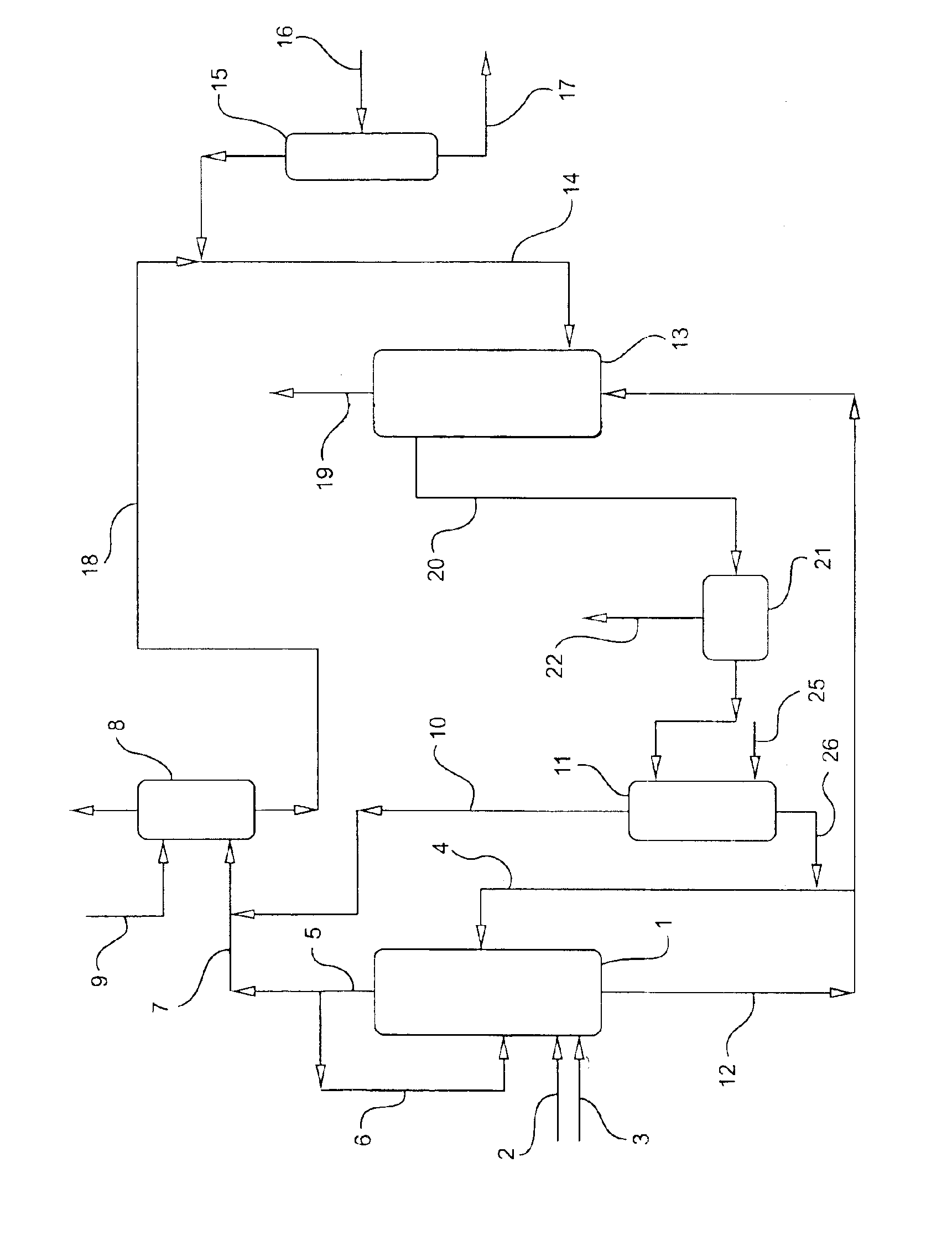Propylene oxide process
a propylene oxide and process technology, applied in the direction of bulk chemical production, organic chemistry, etc., can solve the problems of significant process yield loss, achieve the effect of avoiding the formation of propane and achieving important operation efficiency
- Summary
- Abstract
- Description
- Claims
- Application Information
AI Technical Summary
Benefits of technology
Problems solved by technology
Method used
Image
Examples
example 1
Catalyst Preparation
About 112 parts by weight of spray dried particles of TS-1 (about 30 micron average diameter weighted by volume) comprised of 20 wt % silica binder are slurried in 251 parts by weight deionized water. About 1.3 parts by weight tetra ammine palladium dichloride is dissolved in 90 parts by weight of deionized water. The palladium solution is added to the TS-1 slurry over a 30 minute period with agitation and the mixture is turned at 30 rpm in a 30° C. water bath for 2 hours. The solids are filtered and washed by reslurrying in 140 parts by weight of deionized water and filtering. The solids are washed three more times with 140 parts by weight of deionized water and dried in a vacuum oven at 50° C. for 8 hours to give 109 parts by weight product. The elemental analysis shows; palladium=0.31 wt %, Ti=1.63 wt %. The solids are calcined in air by heating from 23 to 110° C. at 10° C. / min and holding at 110° C. for 4 hours, and then heating at 2° C. / min to 150° C. and ho...
example 2
Propylene Oxide Production
A 100 mL Parr reactor equipped with a stir bar is charged with 150 mg of Pd / TS-1 (0.3 wt % Pd, prepared as in Example 1), 0.22 mg of an HBr solution prepared by mixing a 48 wt % aqueous solution of hydrogen bromide (0.115 grams) with 100 ml deionized water, one gram of deionized water, one gram of an ammonium phosphate buffer (pH=6, 0.1 M) and 16 grams of methanol. The buffer is prepared by dissolving 11.5 parts by weight ammonium dihydrogen phosphate in 800 parts by weight deionized water, aqueous ammonium hydroxide is added until a pH of 6.0 is obtained; deionized water is added to give 1000 parts by weight solution.
The reactor is pressurized to 500 psig with nitrogen and vented to one atmosphere. The reaction mixture is then heated to 30° C., pressurized to 100 psig of hydrogen followed by 4 vol % oxygen / nitrogen to a total pressure of 1287 psig. The reaction mixture with stirring is allowed to react at 30° C. for 60 minutes, cooled to 10° C., and depres...
example 3
Propylene Oxide Production
A 100 mL Parr reactor equipped with a stir bar is charged with 150 mg of Pd / TS-1 (0.3 wt % Pd, prepared as in Example 1), 0.22 gram of an HBr solution (prepared as in Example 2), one gram of deionized water, one gram of an ammonium phosphate buffer (pH 6, 0.1 M) as described in Example 2, and 16 grams of methanol. The reactor is pressurized to 500 psig with nitrogen and vented to one atmosphere. The reaction mixture is then heated to 30° C., pressurized to 100 psig of hydrogen followed by 4% oxygen / nitrogen to a total pressure of 1287 psig. The reaction mixture with stirring is allowed to react at 30° C. for 60 minutes, cooled to 10° C., and depressurized to atmospheric pressure. The liquid phase contains 0.33 wt % hydrogen peroxide.
Propylene (7.6 grams) is then charged and the reactor pressurized to 300 psig with nitrogen. The reaction mixture with stirring is heated to 30° C. for 60 minutes, cooled to 10° C., vented to one atmosphere and the liquid phase ...
PUM
| Property | Measurement | Unit |
|---|---|---|
| molar ratio | aaaaa | aaaaa |
| temperature | aaaaa | aaaaa |
| temperature | aaaaa | aaaaa |
Abstract
Description
Claims
Application Information
 Login to View More
Login to View More - R&D
- Intellectual Property
- Life Sciences
- Materials
- Tech Scout
- Unparalleled Data Quality
- Higher Quality Content
- 60% Fewer Hallucinations
Browse by: Latest US Patents, China's latest patents, Technical Efficacy Thesaurus, Application Domain, Technology Topic, Popular Technical Reports.
© 2025 PatSnap. All rights reserved.Legal|Privacy policy|Modern Slavery Act Transparency Statement|Sitemap|About US| Contact US: help@patsnap.com

